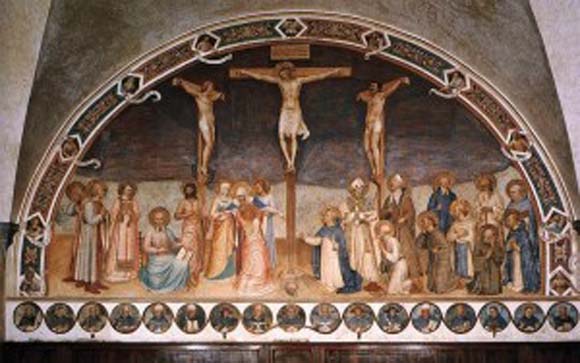
Tuesday of the Fifth Week of Lent – The Son of Man Will Be Lifted Up
 We read in today’s Gospel passage of an impasse of sorts. Simply put the Pharisees cannot understand Jesus; the Pharisees are of this world and Jesus is not, and we read that those who cling to this world will perish in their sins. By this world, John does not aim to denigrate creation, but uses the term to denote all that is contrary to God, all that opposes God in the world. The answer then is to believe in Him and break the stranglehold of this world, the death that comes from sin. To believe, ἐγώ εἰμι, that I am he, is to believe in the Son and in the Father. Christ offers this opportunity for belief to the stubborn Pharisees who are blinded by this world, but to us he offers the further insight of his death and resurrection. To believe in him is to accept the divine relation of the Father and the Son and, when combined with the lifting up of the Son of Man, it is to accept that it is this lifting up that is to be the cause of this insight. We find the Greek verb ὕψωσεν for ‘lifted up’ and note that this verb can be seen to have more than one meaning. On the one hand, it may denote a physical lifting up but alternatively a metaphorical uplifting. John’s use of this verb in his gospel is highly interesting for its double meaning; When you have lifted up the Son of Man, then you will know that I am [he].
We read in today’s Gospel passage of an impasse of sorts. Simply put the Pharisees cannot understand Jesus; the Pharisees are of this world and Jesus is not, and we read that those who cling to this world will perish in their sins. By this world, John does not aim to denigrate creation, but uses the term to denote all that is contrary to God, all that opposes God in the world. The answer then is to believe in Him and break the stranglehold of this world, the death that comes from sin. To believe, ἐγώ εἰμι, that I am he, is to believe in the Son and in the Father. Christ offers this opportunity for belief to the stubborn Pharisees who are blinded by this world, but to us he offers the further insight of his death and resurrection. To believe in him is to accept the divine relation of the Father and the Son and, when combined with the lifting up of the Son of Man, it is to accept that it is this lifting up that is to be the cause of this insight. We find the Greek verb ὕψωσεν for ‘lifted up’ and note that this verb can be seen to have more than one meaning. On the one hand, it may denote a physical lifting up but alternatively a metaphorical uplifting. John’s use of this verb in his gospel is highly interesting for its double meaning; When you have lifted up the Son of Man, then you will know that I am [he].
John’s theology is seen here at its most distinctive and enigmatic. We are pointed to see that in the very act of the lifting up of Christ on the cross Jesus is, as the Son of Man, lifted toward his heavenly glory. It is in this moment of seeming failure and ignominy that Christ is exalted and raised on high. It is in this moment when the world passes judgement on him, that Christ becomes the Judge. We see in this foreshadowing of ‘the hour’ the means by which the breach between heaven and earth will be bridged for all time by Christ as Victor and Judge, as it was foretold in the scriptures. The recognition of the true identity of Christ is precisely what is being presented in this passage as necessary for the liberation of all humanity from sin and death.
Consequently, the content of the ‘lifting up’ cannot just be the Son’s crucifixion but must include the resurrection and lifting up to heaven. The death of Jesus, foretold in this passage, is also seen as his vindication, and by extension, the lifting up forms the basis for the Church on earth, which in turn will share in the divine community of believers, which is realised in this action. The denigration of Christ is his vindication, so that all might be saved. The lifting up of the Son of Man, that focal point of salvific faith, accords with the bronze serpent in the desert. Everyone who looks to the uplifted Christ, and recognises his identity in true belief, will have eternal life. As we near Holy Week, let us try not to be blinkered as the Pharisees; let us recognise the Son of Man for who he really is, and recognise in his lifting up, the means by which we will be lifted up to share in his heavenly glory.


